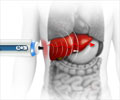Some overweight teens in the West suffer from non-alcoholic fatty liver disease. They have severe liver damage caused by too much body fat, and a handful have needed liver transplants, a new study shows.
Many more may need a new liver by their 30s or 40s, say experts warning that pediatricians need to be more vigilant. The condition, which can lead to cirrhosis and liver failure or liver cancer, is being seen in kids in the United States, Europe, Australia and even some developing countries.The American Liver Foundation and other experts estimate 2 percent to 5 percent of American children over age 5, nearly all of them obese or overweight, have the condition.
"It's clearly the most common cause of liver disease," said Dr. Ronald Sokol, head of public policy at the liver foundation and a liver specialist at Children's Hospital and University of Colorado Denver.
Some experts think as many as 10 percent of all children and half of those who are obese may suffer from it, but note that few are given the simple blood test that can signal its presence. A biopsy is the only sure way to diagnose this disease.
As fat builds up, the liver can become inflamed and then scarred over time, leading to cirrhosis, a serious condition, which in years past was mostly caused by hepatitis or drinking too much alcohol. Liver failure or liver cancer can follow, but if cirrhosis has not yet developed, fatty liver disease can be reversed through weight loss.
The disease is most common in overweight children with belly fat and certain warning signs, such as diabetes or cholesterol or heart problems. However, it's been seen in a few children of normal weight.
Advertisement
"There are people in their 30s or early 40s that will require a liver transplant" from developing the condition as a kid, predicts Dr. Jose Derdoy, head of liver transplants at Cardinal Glennon Children's Medical Center in St. Louis. He's treated a 15-year-old, 530-pound boy and many others with the condition.
Advertisement
Dr. Stephanie Abrams, a liver and obesity specialist at Texas Children's Hospital, said, "The problem is that we aren't changing society in favor of becoming lean."
The scope of the disease has only been realized in recent years. Just a handful of cases were reported in medical journals in the 1980s, and in the past, many adult patients were thought to be lying when they denied drinking alcohol.
Only three liver transplants on American children with nonalcoholic fatty liver disease were recorded from 1990 through 2002; two were done last year.
"It really has been only in the last two or three years that this has become more commonplace," said Dr. Ann Scheimann, a pediatric gastroenterologist at Johns Hopkins Children's Center. "It is scary."
Like heart disease, liver disease is silent. Kids may feel fine for years. Any early symptoms, like fatigue and loss of appetite, are vague and usually eclipsed by more conspicuous problems, from diabetes to high blood pressure.
"The majority of children with this still go undiagnosed," said Dr. Jeffrey Schwimmer, head of the Fatty Liver Clinic at Rady Children's Hospital in San Diego. "Some kids have died."
The best way to combat the problem is to intervene early, while it can still be reversed, with a medical team working with the whole family, including liver and hormone specialists, a dietitian and counselors.
Last spring, the American Academy of Pediatrics recommended doctors do a blood test of liver enzymes every two years on obese children and overweight ones with high blood pressure or cholesterol or family history of heart disease.
Teens who were obese and overweight had a higher risk for chronic diseases such as type 2 diabetes, cardiovascular disease, and fatty liver disease, according to the results of an Australian cross-sectional study reported in the June issue of the Archives of Pediatrics & Adolescent Medicine.
"Several studies have shown that obese children and adolescents have an increased prevalence of metabolic risk factors for cardiovascular disease, type 2 diabetes, and, more recently, fatty liver disease," write Elizabeth Denney-Wilson, PhD, MPH, BN, from the University of Sydney in Sydney, Australia, and colleagues. "Although morbidity could be expected to increase in parallel with the prevalence of obesity, little is known about chronic disease risk factors in the general adolescent population. Most studies of comorbidities either have been conducted in clinic-based groups of severely obese adolescents or have not studied the full range of metabolic complications."
"Overweight and obese adolescents, especially boys, are at substantial risk for chronic conditions," the study authors write. "Waist circumference is not a better predictor of metabolic risk factors than is . . . BMI."
"The propensity of adiposity, behaviors, and risk factors to track from adolescence through adulthood would suggest that health care systems can expect a greater burden of disease from obesity-related conditions when today's young people achieve adulthood," the study authors conclude.
Source-Medindia
GPL













